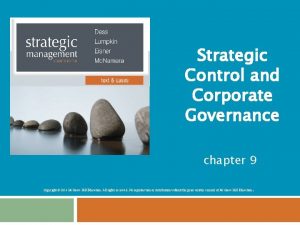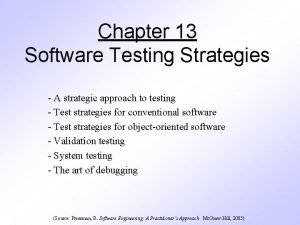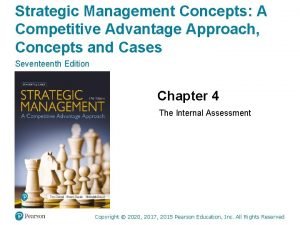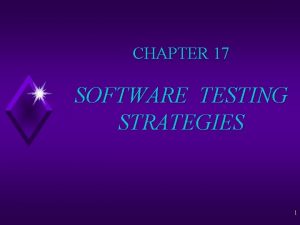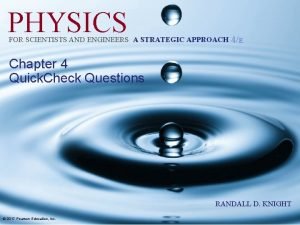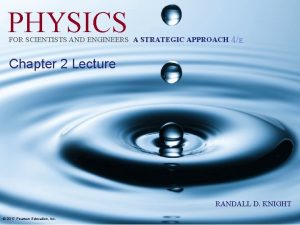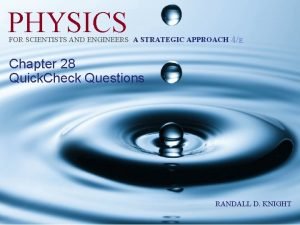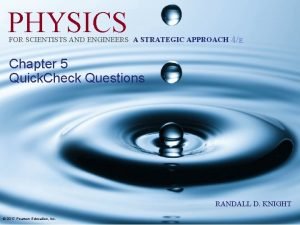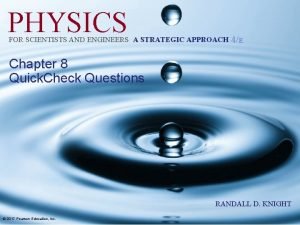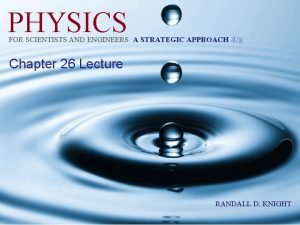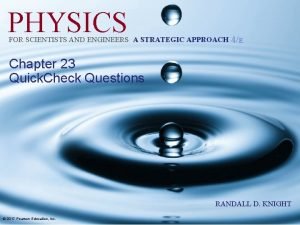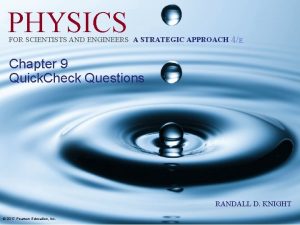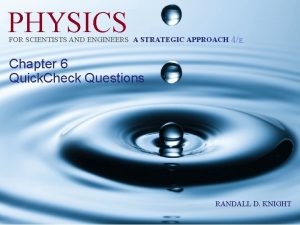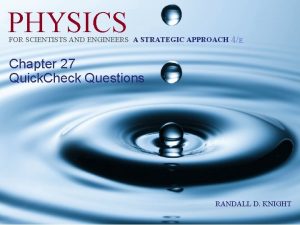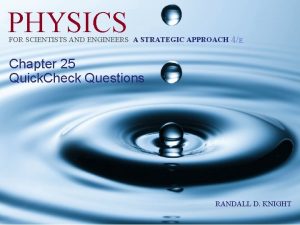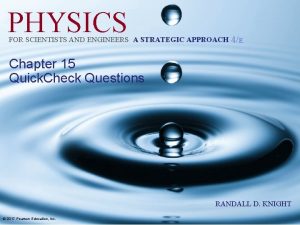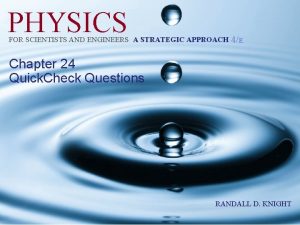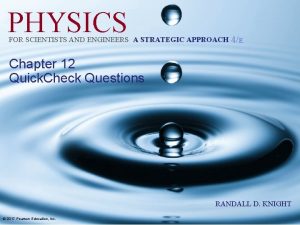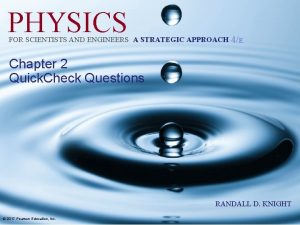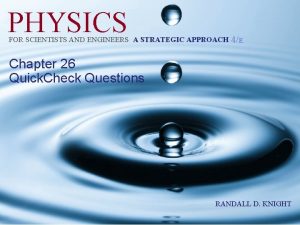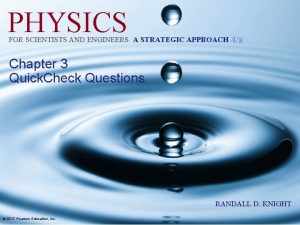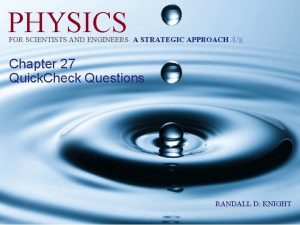PHYSICS FOR SCIENTISTS AND ENGINEERS A STRATEGIC APPROACH



















- Slides: 19

PHYSICS FOR SCIENTISTS AND ENGINEERS A STRATEGIC APPROACH 4/E Chapter 28 Quick. Check Questions RANDALL D. KNIGHT

Quick. Check 28. 1 Does the bulb light? A. Yes B. No C. I’m not sure. © 2017 Pearson Education, Inc. Slide 28 -2

Quick. Check 28. 4 The current through the 3 Ω resistor is A. B. C. D. E. 9 A 6 A 5 A 3 A 1 A © 2017 Pearson Education, Inc. Slide 28 -3

Quick. Check 28. 5 The potential difference across the 10 resistor is A. B. C. D. E. 30 V 20 V 15 V 10 V 5 V © 2017 Pearson Education, Inc. Slide 28 -4

Quick. Check 28. 6 What things about the resistors in this circuit are the same for all three? A. B. C. D. E. Current I Potential difference ΔV Resistance R A and B B and C © 2017 Pearson Education, Inc. Slide 28 -5

Quick. Check 28. 7 Which resistor dissipates more power? A. The 9 Ω resistor B. The 1 Ω resistor C. They dissipate the same power. © 2017 Pearson Education, Inc. Slide 28 -6

Quick. Check 28. 8 Which has a larger resistance, a 60 W lightbulb or a 100 W lightbulb? A. B. C. D. The 60 W bulb The 100 W bulb Their resistances are the same. There’s not enough information to tell. © 2017 Pearson Education, Inc. Slide 28 -7

Quick. Check 28. 9 Which bulb is brighter? A. The 60 W bulb B. The 100 W bulb C. Their brightnesses are the same. D. There’s not enough information to tell. © 2017 Pearson Education, Inc. Slide 28 -8

Quick. Check 28. 10 The battery current I is A. B. C. D. E. 3 A 2 A 1 A 2/3 A 1/2 A © 2017 Pearson Education, Inc. Slide 28 -9

Quick. Check 28. 11 The battery current I is A. B. C. D. E. 3 A 2 A 1 A 2/3 A 1/2 A © 2017 Pearson Education, Inc. Slide 28 -10

Quick. Check 28. 12 When the switch closes, the battery current A. Increases. B. Stays the same. C. Decreases. © 2017 Pearson Education, Inc. Slide 28 -11

Quick. Check 28. 13 The three bulbs are identical and the two batteries are identical. Compare the brightnesses of the bulbs. A. B. C. D. E. A>B>C A>C>B A>B=C A<B=C A=B=C © 2017 Pearson Education, Inc. Slide 28 -12

Quick. Check 28. 14 The three bulbs are identical and the two batteries are identical. Compare the brightnesses of the bulbs. A. B. C. D. E. A B C A C B A B C © 2017 Pearson Education, Inc. Slide 28 -13

Quick. Check 28. 15 The lightbulbs are identical. Initially both bulbs are glowing. What happens when the switch is closed? A. Nothing B. A stays the same; B gets dimmer. C. A gets brighter; B stays the same. D. Both get dimmer. E. A gets brighter; B goes out. © 2017 Pearson Education, Inc. Slide 28 -14

Quick. Check 28. 16 What does the voltmeter read? A. B. C. D. E. 6 V 3 V 2 V Some other value Nothing because this will fry the meter. © 2017 Pearson Education, Inc. Slide 28 -15

Quick. Check 28. 17 What does the ammeter read? A. B. C. D. E. 6 A 3 A 2 A Some other value Nothing because this will fry the meter. © 2017 Pearson Education, Inc. Slide 28 -16

Quick. Check 28. 18 Which capacitor discharges more quickly after the switch is closed? A. Capacitor A B. Capacitor B C. They discharge at the same rate. D. Can’t say without knowing the initial amount of charge. © 2017 Pearson Education, Inc. Slide 28 -17

Quick. Check 28. 19 The capacitor is initially unchanged. Immediately after the switch closes, the capacitor voltage is A. 0 V B. Somewhere between 0 V and 6 V C. 6 V D. Undefined. © 2017 Pearson Education, Inc. Slide 28 -18

Quick. Check 28. 20 The red curve shows how the capacitor charges after the switch is closed at t = 0. Which curve shows the capacitor charging if the value of the resistor is reduced? © 2017 Pearson Education, Inc. Slide 28 -19
 Puppy dog ploy strategy
Puppy dog ploy strategy Industrial organization model of above average returns
Industrial organization model of above average returns Cultural aspects of strategy choice
Cultural aspects of strategy choice Datagram network and virtual circuit network
Datagram network and virtual circuit network Deep learning approach and surface learning approach
Deep learning approach and surface learning approach Strategic fit vs strategic intent
Strategic fit vs strategic intent Incremental approach in strategic management
Incremental approach in strategic management Informational and behavioral control
Informational and behavioral control Strategic choice approach
Strategic choice approach A strategic approach to software testing
A strategic approach to software testing Strategic management a competitive advantage approach
Strategic management a competitive advantage approach A strategic approach to software testing
A strategic approach to software testing Commander approach in strategic management
Commander approach in strategic management Sometimes scientists make a mistake or
Sometimes scientists make a mistake or Diagrams tables and graphs are used by scientists mainly to
Diagrams tables and graphs are used by scientists mainly to Why does it happen
Why does it happen University physics with modern physics fifteenth edition
University physics with modern physics fifteenth edition Physics ia
Physics ia Formuö
Formuö Typiska drag för en novell
Typiska drag för en novell







